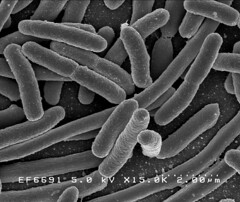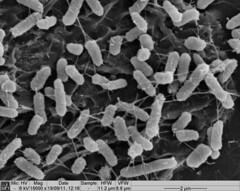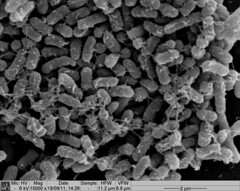Team:Glasgow/BiofilmResults
From 2011.igem.org
| Line 1: | Line 1: | ||
{{Team:Glasgow/Header}} | {{Team:Glasgow/Header}} | ||
<html> | <html> | ||
| - | <p> | + | <h1>Results</h1> |
| + | <p>The images below show a selection of stages of biofilm formation. Starting with Image 1 showing a lab strain of <i>E.coli</i>that has no fimbriae, and is not forming a biofilm.</p> | ||
| + | <p>Image 2 shows an EM of <i>E.coli</i> Nissle 1917 in the early stages of biofilm formation. The fimbriae that allow the cells to cling to each other are clearly visible.</p> | ||
| + | <p>Image 3 shows a Nissle biofilm in the later stages of formation, with the cells densely packed and the extracellular matrix that holds them together showing.</p> | ||
| + | |||
| + | <p> | ||
<div> | <div> | ||
<table align="centre"> | <table align="centre"> | ||
<tr> | <tr> | ||
<td> | <td> | ||
| - | <img src="http://farm7.static.flickr.com/ | + | <img src="http://farm7.static.flickr.com/6171/6170367511_51e5363dbd_m.jpg" width="230" height="170"/> |
| + | <p><font size="1" color="grey"> Image 1: 15,000x EM of E.coli for comparison. </br>No fimbriae or EPS is visible. (courtesy of Rocky Mountain Laboratories)</font></p> | ||
</td> | </td> | ||
<td> | <td> | ||
| - | <img src="http://farm7.static.flickr.com/ | + | <img src="http://farm7.static.flickr.com/6156/6166741226_e4cfd217bd_m.jpg" /><p><font size="1" color="grey">Picture 4: 10,000x SEM image of Nissle </br>showing the fimbriae</font></p> |
| - | <p><font size="1" color="grey"> Picture | + | |
</td> | </td> | ||
<td> | <td> | ||
| - | <img src="http://farm7.static.flickr.com/ | + | <img src="http://farm7.static.flickr.com/6177/6166139079_a35d6a5930_m.jpg" width="230" height="180" /><p><font size="1" color="grey">Image 3: SEM image of Nissle biofilm </br>showing the extracellular matrix</font></p> |
| - | <p><font size="1" color="grey"> | + | |
</td> | </td> | ||
| + | </tr> | ||
| + | <tr align="centre"> | ||
| + | <td> | ||
| + | <img src="http://farm7.static.flickr.com/6177/6170913398_6e217cc778_m.jpg"/> | ||
| + | <p><font size="1" color="grey">Image 1: 1000x EM of P. aeruginosa biofilm, showing its densely packed structure </br>(courtesy of Dan Walker, University of Glasgow)</font></p> | ||
| + | </td> | ||
| + | </tr> | ||
</table> | </table> | ||
</div> | </div> | ||
</br> | </br> | ||
| - | + | ||
| - | + | ||
| - | + | ||
| - | + | ||
| - | + | ||
| - | + | ||
| - | + | ||
| - | + | ||
| - | + | ||
| - | + | ||
| - | + | ||
</table> | </table> | ||
</div> | </div> | ||
</html> | </html> | ||
Revision as of 00:53, 22 September 2011

Results
The images below show a selection of stages of biofilm formation. Starting with Image 1 showing a lab strain of E.colithat has no fimbriae, and is not forming a biofilm.
Image 2 shows an EM of E.coli Nissle 1917 in the early stages of biofilm formation. The fimbriae that allow the cells to cling to each other are clearly visible.
Image 3 shows a Nissle biofilm in the later stages of formation, with the cells densely packed and the extracellular matrix that holds them together showing.

Image 1: 15,000x EM of E.coli for comparison. No fimbriae or EPS is visible. (courtesy of Rocky Mountain Laboratories) |
 Picture 4: 10,000x SEM image of Nissle showing the fimbriae |
 Image 3: SEM image of Nissle biofilm showing the extracellular matrix |

Image 1: 1000x EM of P. aeruginosa biofilm, showing its densely packed structure (courtesy of Dan Walker, University of Glasgow) |
 "
"
